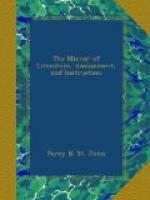We attempt something like an outline of the plot, although it is just to induce Our reader to turn to the work itself, for we foretel he will be pleased with its details. Artevelde, a beer brewster of Ghent, intrigues with Edward to transfer the coronet of Flanders from Count Lewis to the young Prince of Wales. The scheme fails, and Artevelde perishes in an affray with the citizens In his negotiations he had employed his daughter, and dispatched her on one occasion, in a private yacht, to the Thames, to confer with the King. In her passage she is observed and recognised by the follower of a Flemish noble, who has a direct interest in defeating Artevelde’s scheme for the marriage and settlement of his daughter, who, before she reaches the King, is seized by this noble and his agents, but is rescued by a brave young citizen. Here the love begins. This young citizen is the nephew of a wealthy old goldsmith, but he abominates the traffic and filthy lucre of his uncle’s profession—for, it should be added, the goldsmiths were the money-jobbers of those days—and aspires to become a soldier of fortune. London was a fitting place for such ambition, for those were chivalrous times. Artevelde’s daughter entrusts the youth with the commission, and dispatches him to the King: he acquits himself with courtly discretion, and, having displayed some prowess in a passage of arms, soon obtains an appointment in the royal service. Edward’s interview with the lady determines him to start instantly for Flanders, and the young citizen (Borgia) accompanies him. They fall into the hands of the same Flemish noble who had attacked the heroine; but they are rescued, and land at the Flemish coast.—The scheme fails, as we have said: after Artevelde’s death, his daughter becomes the King’s ward. The interests of the parties now become too complicated for us to follow: we may, however, state that “the King’s Secret” is the parentage of Borgia; it was asserted that he was “the very child reported to have been born during the period of Queen Isabella’s romantic love passages with Roger Mortimer, at the court of Hainault.”—“Be content, therefore, with that you and til here already are possessed of, since what remains is, and must continue, ‘The King’s Secret.’”
The heroine is the gemmy character of the story; but, in that of the King so much license has been used as almost to defy its identification with history. Scenes, situations, and sketches, of uncommon interest, abound throughout the work; the manners and customs of the times, and the details of costume and pageant glitter are worked up with great labour—perhaps with more than is looked for or will be appreciated in a novel. Still, they are creditable to the taste and research of the author. Occasionally, there are scenes of bold and stirring interest, just such as might be expected from an actor of Mr. Power’s vivid stamp. The storm sketches towards the close of the second volume are even infinitely better than any of John Kemble’s shilling waves or Mr. Farley’s last scenes. In other portions of the work, bits of antiquarianism are so stuck on the pages as to perplex, rather than aid the descriptions, by their technicality. Here and there too the tinsel is unsparingly sprinkled.




